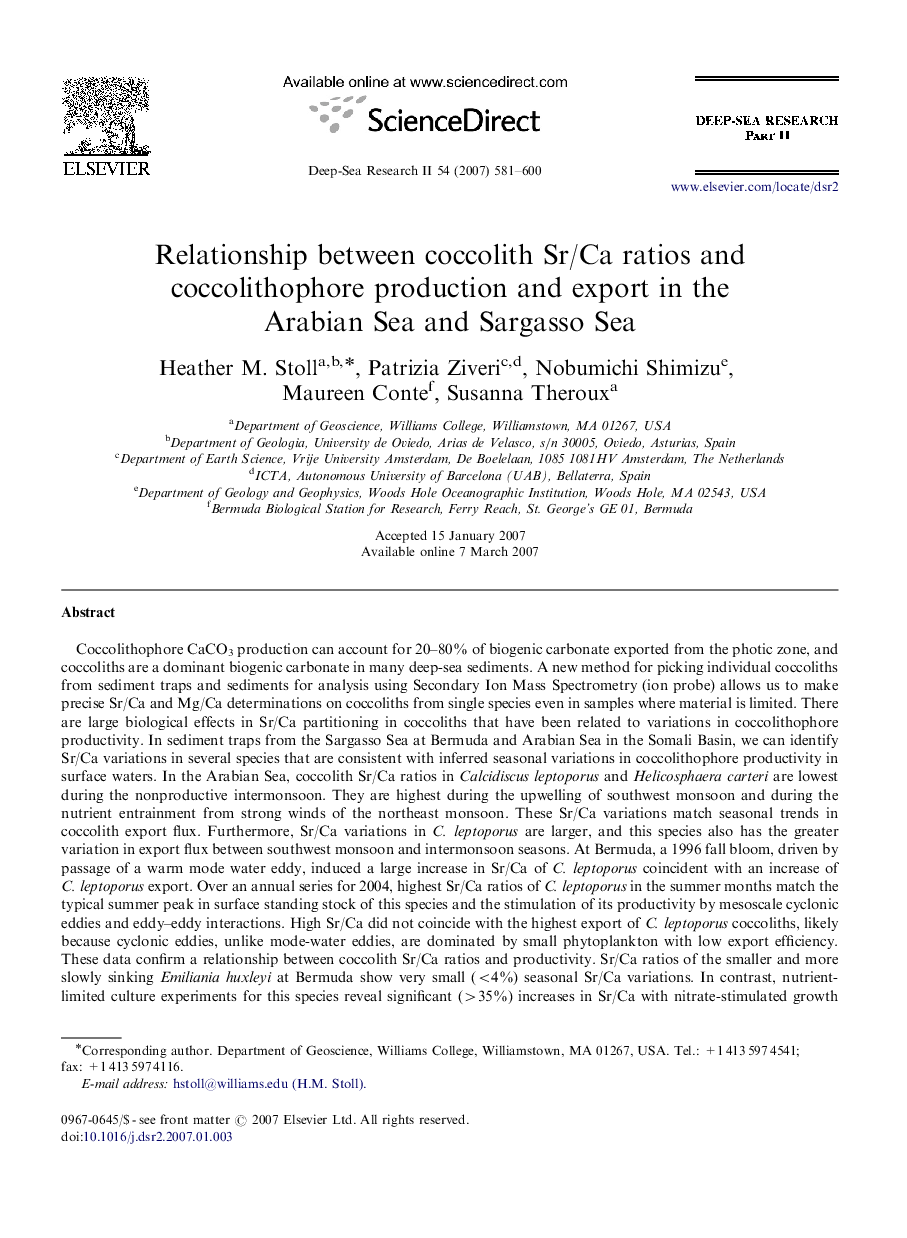| کد مقاله | کد نشریه | سال انتشار | مقاله انگلیسی | نسخه تمام متن |
|---|---|---|---|---|
| 4537636 | 1626507 | 2007 | 20 صفحه PDF | دانلود رایگان |
عنوان انگلیسی مقاله ISI
Relationship between coccolith Sr/Ca ratios and coccolithophore production and export in the Arabian Sea and Sargasso Sea
دانلود مقاله + سفارش ترجمه
دانلود مقاله ISI انگلیسی
رایگان برای ایرانیان
کلمات کلیدی
موضوعات مرتبط
مهندسی و علوم پایه
علوم زمین و سیارات
زمین شناسی
پیش نمایش صفحه اول مقاله

چکیده انگلیسی
Coccolithophore CaCO3 production can account for 20-80% of biogenic carbonate exported from the photic zone, and coccoliths are a dominant biogenic carbonate in many deep-sea sediments. A new method for picking individual coccoliths from sediment traps and sediments for analysis using Secondary Ion Mass Spectrometry (ion probe) allows us to make precise Sr/Ca and Mg/Ca determinations on coccoliths from single species even in samples where material is limited. There are large biological effects in Sr/Ca partitioning in coccoliths that have been related to variations in coccolithophore productivity. In sediment traps from the Sargasso Sea at Bermuda and Arabian Sea in the Somali Basin, we can identify Sr/Ca variations in several species that are consistent with inferred seasonal variations in coccolithophore productivity in surface waters. In the Arabian Sea, coccolith Sr/Ca ratios in Calcidiscus leptoporus and Helicosphaera carteri are lowest during the nonproductive intermonsoon. They are highest during the upwelling of southwest monsoon and during the nutrient entrainment from strong winds of the northeast monsoon. These Sr/Ca variations match seasonal trends in coccolith export flux. Furthermore, Sr/Ca variations in C. leptoporus are larger, and this species also has the greater variation in export flux between southwest monsoon and intermonsoon seasons. At Bermuda, a 1996 fall bloom, driven by passage of a warm mode water eddy, induced a large increase in Sr/Ca of C. leptoporus coincident with an increase of C. leptoporus export. Over an annual series for 2004, highest Sr/Ca ratios of C. leptoporus in the summer months match the typical summer peak in surface standing stock of this species and the stimulation of its productivity by mesoscale cyclonic eddies and eddy-eddy interactions. High Sr/Ca did not coincide with the highest export of C. leptoporus coccoliths, likely because cyclonic eddies, unlike mode-water eddies, are dominated by small phytoplankton with low export efficiency. These data confirm a relationship between coccolith Sr/Ca ratios and productivity. Sr/Ca ratios of the smaller and more slowly sinking Emiliania huxleyi at Bermuda show very small (<4%) seasonal Sr/Ca variations. In contrast, nutrient-limited culture experiments for this species reveal significant (>35%) increases in Sr/Ca with nitrate-stimulated growth rates. The high dominance of E. huxleyi production during bloom events, coupled with suspension of small E. huxleyi coccoliths below the photic zone with very long transport times, appears to attenuate significantly the amplitude of Sr/Ca variations in trap material. Coccoliths from these traps possess low Mg/Ca ratios characteristic of low-Mg calcite, so that higher Mg ratios obtained in some extant coccoliths in cultures are not representative of typical open-ocean coccoliths recovered in sediment trap samples. A significant correlation of Mg/Ca with sea-surface temperature is observed only for H. carteri coccoliths in the Arabian Sea, and not in C. leptoporus in either site.
ناشر
Database: Elsevier - ScienceDirect (ساینس دایرکت)
Journal: Deep Sea Research Part II: Topical Studies in Oceanography - Volume 54, Issues 5â7, MarchâApril 2007, Pages 581-600
Journal: Deep Sea Research Part II: Topical Studies in Oceanography - Volume 54, Issues 5â7, MarchâApril 2007, Pages 581-600
نویسندگان
Heather M. Stoll, Patrizia Ziveri, Nobumichi Shimizu, Maureen Conte, Susanna Theroux,